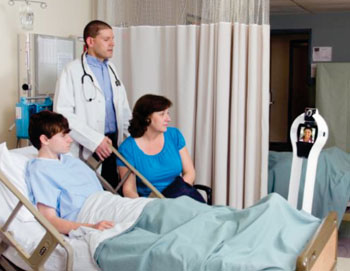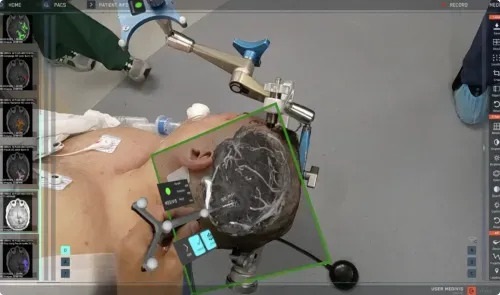Telehealth Robot Crosses Language Barriers
|
By HospiMedica International staff writers Posted on 20 May 2014 |

Image: VEGO enables doctors to monitor and consult with patients, families, and staff (Photo courtesy of the Weisman Children\'s Rehabilitation Hospital).
Weisman Children's Rehabilitation Hospital (Marlton, NJ, USA), a leading provider of pediatric rehabilitation services, is adding a new member to its clinical staff— VEGO the telehealth robot.
VEGO—whose official name will be determined later by patients, who will vote on the best suggested name—allows doctors to extend their reach to monitor and consult with patients, families, and staff at Weisman when they cannot be there in person, or to solve a developing condition that would otherwise require transport of a patient and interruption of rehabilitation therapy. VEGO also assists in translation services by acting as a portal between the translator and the patient and family. VEGO can also be used to allow other family members to "visit" loved ones when they can't be there in person.
VEGO is integrated with a camera, microphones, and video display, all on a light-weight, motorized, remote-controlled platform. It is one meter tall, so it works equally well when interacting with people who are sitting or standing. An accessory can raise the height to 1.25 m for applications where people are always standing, or when a higher view is needed. VEGO is battery powered and recharges by automatically positioning itself on its charging dock. VEGO was developed by VGo Communications (Nashua, NH, USA), which produces robotic telepresence solutions for healthcare, education, and the workplace.
“The language phone line works well but whenever you can have people connecting face to face, there is a greater level of comfort and understanding since a large part of communication is nonverbal,” said Mike Rosiak, COO of Weisman Children's. “Recently a family connected with loved ones in Puerto Rico through VEGO.”
Weisman Children's Rehabilitation Hospital is a leading provider of pediatric rehabilitation services on an inpatient, outpatient, and medical day care basis, serving children in five facilities throughout South Jersey. It employs more than 300 administration and clinical staff. Weisman's VEGO will be introduced to the public at the grand opening celebration of the expanded and relocated medical daycare and outpatient site at in Pennsauken (NJ, USA). During the grand opening, VEGO will lead the ribbon cutting ceremony with elected officials, Weisman administration, and patient families.
Related Links:
Weisman Children's Rehabilitation Hospital
VGo Communications
VEGO—whose official name will be determined later by patients, who will vote on the best suggested name—allows doctors to extend their reach to monitor and consult with patients, families, and staff at Weisman when they cannot be there in person, or to solve a developing condition that would otherwise require transport of a patient and interruption of rehabilitation therapy. VEGO also assists in translation services by acting as a portal between the translator and the patient and family. VEGO can also be used to allow other family members to "visit" loved ones when they can't be there in person.
VEGO is integrated with a camera, microphones, and video display, all on a light-weight, motorized, remote-controlled platform. It is one meter tall, so it works equally well when interacting with people who are sitting or standing. An accessory can raise the height to 1.25 m for applications where people are always standing, or when a higher view is needed. VEGO is battery powered and recharges by automatically positioning itself on its charging dock. VEGO was developed by VGo Communications (Nashua, NH, USA), which produces robotic telepresence solutions for healthcare, education, and the workplace.
“The language phone line works well but whenever you can have people connecting face to face, there is a greater level of comfort and understanding since a large part of communication is nonverbal,” said Mike Rosiak, COO of Weisman Children's. “Recently a family connected with loved ones in Puerto Rico through VEGO.”
Weisman Children's Rehabilitation Hospital is a leading provider of pediatric rehabilitation services on an inpatient, outpatient, and medical day care basis, serving children in five facilities throughout South Jersey. It employs more than 300 administration and clinical staff. Weisman's VEGO will be introduced to the public at the grand opening celebration of the expanded and relocated medical daycare and outpatient site at in Pennsauken (NJ, USA). During the grand opening, VEGO will lead the ribbon cutting ceremony with elected officials, Weisman administration, and patient families.
Related Links:
Weisman Children's Rehabilitation Hospital
VGo Communications
Latest Hospital News News
- Nurse Tracking System Improves Hospital Workflow
- New Children’s Hospital Transforms California Healthcare
- Noisy Hospitals Face Threat of Decreased Federal Compensation
- Orthopedics Centre of Excellence Planned for Guy’s Hospital
- Research Suggests Avoidance of Low-Value Surgical Procedures
- U.S. Federal Readmission Fines Linked to Higher Mortality
- Columbia China to Build New Hospital in Jiaxing
- Dubai Debuts Second Robotic Pharmacy Service
- Seattle Hospital Network Shifts Away from Overlapping Surgeries
- ACC to Launch Valvular Heart Disease Program in China
- Mortality Rates Lower at Major Teaching Hospitals
- South Australia to Inaugurate Upscale Hospital
- Raffles to Launch Second Hospital Project in China
- Research Center Tackles Antimicrobial Drugs Challenge
- Miami Cardiac & Vascular Institute Completes Expansion Project
- Hospital Antibiotic Policies Improve Prescription Practices
Channels
Artificial Intelligence
view channel
AI-Powered Algorithm to Revolutionize Detection of Atrial Fibrillation
Atrial fibrillation (AFib), a condition characterized by an irregular and often rapid heart rate, is linked to increased risks of stroke and heart failure. This is because the irregular heartbeat in AFib... Read more
AI Diagnostic Tool Accurately Detects Valvular Disorders Often Missed by Doctors
Doctors generally use stethoscopes to listen for the characteristic lub-dub sounds made by heart valves opening and closing. They also listen for less prominent sounds that indicate problems with these valves.... Read moreCritical Care
view channel.jpeg)
Transcatheter Valve Replacement Outcomes Similar To Surgery, Finds Study
A new study has shown that a minimally invasive procedure for replacing the aortic valve in the heart—known as transcatheter aortic valve replacement (TAVR)—is on par with the more traditional surgical... Read more
Revascularization Improves Life Quality in Chronic Limb-Threatening Ischemia, Finds Study
Researchers have undertaken a detailed study to evaluate the effects of revascularization strategies on the health-related quality of life (HRQoL) of patients with chronic limb-threatening ischemia.... Read moreSurgical Techniques
view channel
AR Surgical Technology Translates Complex 2D Medical Imaging to Enhance Accuracy
Surgeons often have to switch their focus between a patient’s data displayed on a screen or clipboard and the patient themselves during procedures. But that is about to change. Surgeons can now utilize... Read more
Miniaturized Snake-Like Probe Images Cerebral Arteries From Within
Endovascular interventions are being increasingly favored for treating strokes and cerebral artery diseases, but rely heavily on angiographical imaging that often struggles with limited contrast and spatial... Read morePatient Care
view channelFirst-Of-Its-Kind Portable Germicidal Light Technology Disinfects High-Touch Clinical Surfaces in Seconds
Reducing healthcare-acquired infections (HAIs) remains a pressing issue within global healthcare systems. In the United States alone, 1.7 million patients contract HAIs annually, leading to approximately... Read more
Surgical Capacity Optimization Solution Helps Hospitals Boost OR Utilization
An innovative solution has the capability to transform surgical capacity utilization by targeting the root cause of surgical block time inefficiencies. Fujitsu Limited’s (Tokyo, Japan) Surgical Capacity... Read more
Game-Changing Innovation in Surgical Instrument Sterilization Significantly Improves OR Throughput
A groundbreaking innovation enables hospitals to significantly improve instrument processing time and throughput in operating rooms (ORs) and sterile processing departments. Turbett Surgical, Inc.... Read moreHealth IT
view channel
Machine Learning Model Improves Mortality Risk Prediction for Cardiac Surgery Patients
Machine learning algorithms have been deployed to create predictive models in various medical fields, with some demonstrating improved outcomes compared to their standard-of-care counterparts.... Read more
Strategic Collaboration to Develop and Integrate Generative AI into Healthcare
Top industry experts have underscored the immediate requirement for healthcare systems and hospitals to respond to severe cost and margin pressures. Close to half of U.S. hospitals ended 2022 in the red... Read more
AI-Enabled Operating Rooms Solution Helps Hospitals Maximize Utilization and Unlock Capacity
For healthcare organizations, optimizing operating room (OR) utilization during prime time hours is a complex challenge. Surgeons and clinics face difficulties in finding available slots for booking cases,... Read more
AI Predicts Pancreatic Cancer Three Years before Diagnosis from Patients’ Medical Records
Screening for common cancers like breast, cervix, and prostate cancer relies on relatively simple and highly effective techniques, such as mammograms, Pap smears, and blood tests. These methods have revolutionized... Read morePoint of Care
view channel
Critical Bleeding Management System to Help Hospitals Further Standardize Viscoelastic Testing
Surgical procedures are often accompanied by significant blood loss and the subsequent high likelihood of the need for allogeneic blood transfusions. These transfusions, while critical, are linked to various... Read more
Point of Care HIV Test Enables Early Infection Diagnosis for Infants
Early diagnosis and initiation of treatment are crucial for the survival of infants infected with HIV (human immunodeficiency virus). Without treatment, approximately 50% of infants who acquire HIV during... Read more
Whole Blood Rapid Test Aids Assessment of Concussion at Patient's Bedside
In the United States annually, approximately five million individuals seek emergency department care for traumatic brain injuries (TBIs), yet over half of those suspecting a concussion may never get it checked.... Read more
New Generation Glucose Hospital Meter System Ensures Accurate, Interference-Free and Safe Use
A new generation glucose hospital meter system now comes with several features that make hospital glucose testing easier and more secure while continuing to offer accuracy, freedom from interference, and... Read moreBusiness
view channel
Johnson & Johnson Acquires Cardiovascular Medical Device Company Shockwave Medical
Johnson & Johnson (New Brunswick, N.J., USA) and Shockwave Medical (Santa Clara, CA, USA) have entered into a definitive agreement under which Johnson & Johnson will acquire all of Shockwave’s... Read more


















